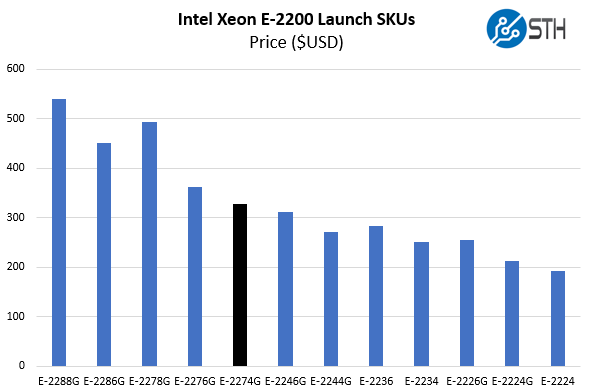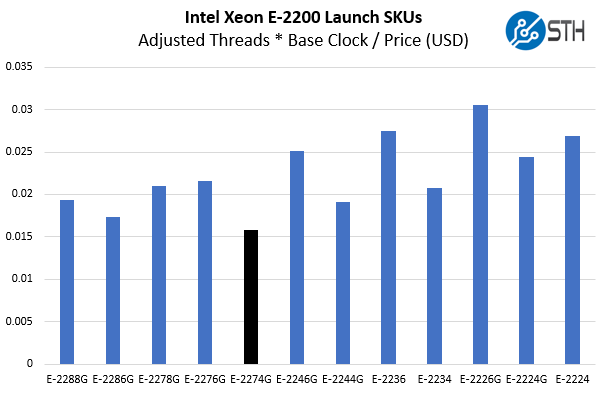Intel Xeon E-2274G Power Consumption
We wanted to post a few figures from our testing that show the real selling point of the chips, low power.
Idle is around 32W and maximum power consumption hits just under 109W in our testbed. Although the increase in TDP does not translate directly to increased power consumption, the Intel Xeon E-2274G we can recommend for extremely power-constrained environments like 1A in 110V or 120V rack deployments. For the low-cost colocation world, this is a viable option but it is very close to the point that additional drives and peripherals can make the difference.
Note these results were taken using a 208V Schneider Electric / APC PDU at 17.7C and 72% RH. Our testing window shown here had a +/- 0.3C and +/- 2% RH variance. We double-checked on our 120V racks and were able to get power consumption over that common 1A threshold.
Intel Xeon E-2274G Market Positioning
The Intel Xeon E-2274G is not being released in a vacuum. Instead, there are other parts available in the socket which means that our readers need to decide on a chip in the context of a configurator. Here is what the parts look like ordered by part number:

The “trick” in the Xeon E-2200 series is that the third digit is a level of performance in the context of the fourth digit that represents the core count. It is important for our readers to know that the highest numerical model number does not mean the highest performance, aside from the Xeon E-2288G.
Taking a look at how the Intel Xeon E-2274G stacks up against its stablemates when we take into account threads, clock speed, and price, this is what the above chart looks like:

This chart shows the relative value of each part to see how much compute each incremental list price dollar buys. Here, the Intel Xeon E-2274G is certainly not the highest on our list. Indeed, even the Intel Xeon E-2224 is a better value. Although we have not benchmarked this generation’s Xeon E-2246G, based on the previous generation Xeon E-2146G, we can see how that is attractive.
The Intel Xeon E-2246G is a lower-cost part, with a 3W lower TDP. One loses 100MHz of top clock speeds and 400MHz on the base clock versus the Xeon E-2274G. What one gains, is 50% more cores and threads (6C/12T.) That is why we see that SKU as a better value.
At $328, the Intel Xeon E-2274G is an extremely tough sell if AMD ever enters this market. There are some niche platforms like the ASRock Rack X570D4I-2T 3rd Gen AMD Ryzen mITX with Dual 10GbE that can make that a reality. Still, AMD has not committed the engineering resources to this market. If it did, the AMD Ryzen 3700X at virtually the same price point does not have the iGPU but has 8 cores and 16 threads in only 65W TDP, and it supports PCIe Gen4. If you compare the server ecosystem for Ryzen v. Intel Xeon E, it is not even close. Tier 1 vendors all support Xeon E. There are many platforms available. Still, if AMD enters this market, parts like the Xeon E-2274G will become obsolete.
The other elephant in the room for the Intel Xeon E-2274G is virtualization. As the Intel Xeon Silver series has added cores and AMD EPYC 7002 series offers more x86 compute per socket, there is at least some discussion to be had about whether there is still a viable market beyond deployments of 1-3 small physical nodes. With the six and eight-core parts, this is less of a concern, but with four cores and eight threads, we see the Xeon E-2274G as having limited potential for larger-scale deployments.
Final Words
All told, the Intel Xeon E-2274G is still a strong quad-core part. A 200MHz bump for both base and turbo clocks over the previous generation is welcome. For many of our readers, we think the Xeon E-2246G is a better buy as adding two more cores at a lower cost and lower TDP seems to make sense. Still, if you are focused on buying a quad-core part, this is potentially the best quad-core server CPU on the market.




The AsRockRack X470D4U2-2T looks to be a pretty competitive.
Supports AMD AM4 Socket Ryzen™ Series CPUs
Supports 4x DDR4 ECC and non-ECC UDIMM, max. 128 GB
Supports up to 6 x SATA3 6.0Gb/s (inculded 1 SATA DOM), 2 x M.2
Integrated IPMI 2.0 with KVM and Dedicated LAN (RTL8211E)
Supports2 x RJ45 10G base-T by Intel X550-AT2
Supports 2 x PCIe 3.0 x16, 1 x PCIE 2.0 x1
Together with a same priced R7 3700x
What’s wrong with using any of the numerous am4 boards that have the traces for the full 72 bit ecc memory interface and thus support ecc udimms?
But yeah, there is absolutely no valid reason for amd to neglect the fairly easily attainable possibility to trash intel in that market too. It is understandable why they went after big money first, but now that they are dominating the high end, maybe put some effort into validation and promotion of low end servers.
4 core, 8 thread, 4.0 Ghz base clock, and 8MB of cache for $328? Is this 2014?
That’s the exact same specs as the 4790K Haswell chip from 2014, even down to the price point.
DGO the big win is Out of band IPMI Port and AST2500 BMC
Still a good chip for an application server now it’s coming down to the discount market at dedicated server hosts. Many user-facing operations can still be single-threaded, and it boosts to 4.9/4.8/4.6/4.4Ghz – though perhaps less at more power with AVX2; my system will run it at 83W for 28s. Obviously if you need AVX-512, Xeon D is the way.
There’s equivalent boards, E3C246D4U2-2T or similar – the NVMe-supporting E3C246D4I-2T was reviewed here – with the AST2500.